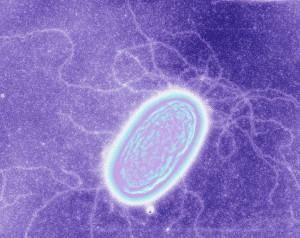While scientists learn more with each passing study about the way the invisible lives of fungi, bacteria, viruses and other microscopic organisms intersect with much larger plants and animals as well as the planet, Tim Donohue and a group of prominent scientists want to make sure researchers don’t miss the giant forest for the tiny trees.
Donohue, a UW–Madison bacteriology professor and director of theGreat Lakes Bioenergy Research Center, joined 17 other scientists from around the world and representing a wide range of disciplines today (Oct. 28, 2015) to lay out a case for an organized approach to harnessing the power of microbes to tackle many of the world’s most pressing problems.
Led by Jeff F. Miller, a microbiology professor at the University of California, Los Angeles, in the journal Science, and microbiologist Nicole Dubilier of Germany’s Max Planck Institute for Marine Microbiology, in Nature, the authors proposed a Unified Microbiome Initiative to supply key knowledge and techniques to address sustainable agriculture, chemical and energy production, climate change, disease and more.
Discoveries ancient and modern illustrate the importance of microbes.
The geological record provides evidence of how ancestors of today’s microbes helped shape our planet. Microbes provide the oxygen we breathe, break down contaminants in water, help us digest and absorb nutrients in our food, and pass nitrogen in soil to hungry plants.
Yeast leavens bread and ferments beer, but also has a hand in the production of insulin, vaccines and industrial chemicals. Viruses may help guide normal development in animals, are a source of gene exchange in the oceans, and have stepped up as powerful tools for the study of genetics and delivery of gene therapies.
But much of what researchers have learned about the specific workings of the ubiquitous little “bugs” remains walled up within each microbe or group of microbes’ home range — or the particular branch of science practiced by the experts, according to Donohue.
“A variety of people in the academic community, the private sector and the federal government really feel it’s time to take the analysis of microbial communities to the next level,” he says. “That means moving beyond using genome sequences to obtain a census of which microbes are where, and tackling the next big challenge: understanding what communities of microbes are doing in different environments.”
A Unified Microbiome Initiative could help collect and process enormous amounts of information about dozens or hundreds or thousands of types of microbes that are born, eat, excrete, fight, die and evolve together — all the while making a fundamental difference in the environment they inhabit.
“What we need is an influx of people from other fields to work with the biochemists and microbiologists and engineers who have typically studied microbes in isolation,” Donohue says.
If scientists could accurately model communities of microbes, and anticipate how changes at the microscopic level make for changes visible on the human scale, they can anticipate problems and use microbes to create next-generationsolutions to grand societal problems.
“That has enormous potential for the health of the planet and the health of people. It could make personalized medicine work. It could create new energy sources and be the catalyst for next-generation bio-based manufacturing. It could grow food and provide clean water,” Donohue says. “Twenty years from now we may look back at this as a watershed time where we began to take information on microbes and use them as predictors of human health and influencers of planetary activities on a new scale.”
That would require organization and support for research that develops tools for exploring microbial communities and put those tools in the hands of multidisciplinary teams of scientists and engineers, according to the researchers writing in Nature and Science.
Donohue sees enthusiasm from U.S. governmental agencies and major private research philanthropic organizations for a collective push like the BRAIN Initiative, launched in 2013 by the White House’s Office of Science and Technology Policy (OSTP) to advance neuroscience. The initiative incorporates hundreds of millions of dollars in research supported by federal agencies, the pharmaceutical and medical imaging industries, and nonprofits like the Kavli Foundation.
OSTP and the Kavli Foundation have separately organized recent meetings where scientists fleshed out a vision of a Unified Microbiome Initiative.
“It’s important that this be an international effort,” Donohue says. “This is a problem the United States has the brain power and the resources to be a leader in. But to do it right, it is critical that we take advantage of the expertise that exists around the globe. Because these are problems — medicine, energy, food — we face collectively.”
UW–Madison — where researchers are investigating the roles microbes play in lifelong health, plant productivity, wastewater treatment, manufacturing and more — is uniquely positioned to play a role in a concerted effort to broaden the way science studies and makes use of microbes.
“We have expertise in every arena that needs to be pulled in to contribute, beginning with a world-class cadre of microbiologists and a spirit of collaboration,” Donohue says. “Our medical school, veterinary school, strong engineering, agricultural experts, leaders in oceanography — if we can find a way here to connect teams of these people with researchers in analytics and computation, we can be a model for the country and the world.”
If our reporting has informed or inspired you, please consider making a donation. Every contribution, no matter the size, empowers us to continue delivering accurate, engaging, and trustworthy science and medical news. Independent journalism requires time, effort, and resources—your support ensures we can keep uncovering the stories that matter most to you.
Join us in making knowledge accessible and impactful. Thank you for standing with us!

